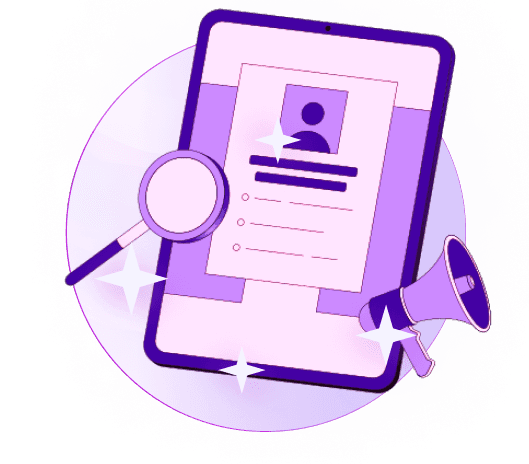Blogs
Articles

How to Use LinkedIn for Prospecting: A 6-Step Guide for Sales Teams
In the digital age of sales, leveraging social media platforms like LinkedIn has become a crucial tool for prospecting and lead generation. This 6-step guide is designed to equip sales teams with the knowledge and strategies needed to effectively utilize LinkedIn for prospecting purposes.
From optimizing profiles to engaging with connections and utilizing advanced search features, each step is tailored to maximize results and drive sales success. By following this comprehensive guide, sales professionals can tap into the vast networking potential of LinkedIn to identify and connect with prospects, nurture relationships, and ultimately boost their sales pipeline.
Whether you are a seasoned sales veteran or new to the game, mastering the art of prospecting on LinkedIn can open doors to valuable opportunities and help you stay ahead in the competitive world of sales.
Get ready to supercharge your prospecting efforts and unlock a wealth of potential leads with this practical and actionable 6-step guide.
Optimizing Your LinkedIn Profile for Prospecting
Creating a Professional and Compelling LinkedIn Profile
Having a strong online presence is crucial for professionals across all industries. When it comes to sales prospecting, your LinkedIn profile serves as a powerful tool for making connections, building relationships, and ultimately driving sales. To optimize your profile for prospecting success, consider the following tips:.
Crafting a Standout Headline and Summary
Your headline and summary are the first things that potential prospects will see on your profile. Make sure your headline is clear, concise, and highlights your unique selling proposition. Your summary should provide a compelling overview of your experience, skills, and what you can offer to potential clients.
Showcasing Relevant Experience and Skills
Highlighting your relevant experience and skills is essential for establishing credibility with prospects. Be sure to showcase any past successes, projects, or achievements that demonstrate your expertise in your field. Endorsements and recommendations from colleagues and clients can also help strengthen your profile.
Utilizing Rich Media
Incorporating rich media such as videos, presentations, or links to articles can make your profile more engaging and visually appealing. This can help showcase your work in a dynamic way and provide prospects with a deeper insight into your capabilities.
Engaging with Connections and Consistent Activity
Building relationships on LinkedIn is key to successful prospecting. Engage with your connections by sharing valuable content, commenting on posts, and participating in relevant discussions. Consistent activity on the platform will help keep you top of mind with your network.
Leveraging Recommendations, Endorsements, and Networking
Seek recommendations and endorsements from clients and colleagues to add credibility to your profile. Additionally, network strategically by connecting with professionals in your industry or target market. Joining relevant groups and participating in networking events can also help expand your reach.
Measuring Success and Making Adjustments
Monitor your LinkedIn activity and track key metrics such as profile views, connection requests, and engagement on your posts. Use this data to make informed decisions and adjustments to your profile and prospecting strategy.
By following these tips and optimizing your LinkedIn profile for prospecting, you can enhance your online presence, build valuable connections, and drive sales opportunities. Remember, your profile is a reflection of your personal brand, so invest the time and effort to make it stand out in a competitive digital landscape.
Engaging with Content and Connections
Engagement plays a crucial role in building a strong online presence. Whether you are a business looking to attract leads or an individual trying to grow your network, engaging with content and connections is key. Let's delve into the importance of these interactions:.
The Power of Authentic Engagement
When you engage with posts, comments, and messages on social media platforms or online forums, you are not just passively consuming content but actively participating in the conversation. Authentic engagement involves more than just liking a post; it's about adding value through meaningful comments, sharing personal experiences, or providing insights that spark further discussion. By genuinely engaging with others, you can establish trust, credibility, and a sense of community within your online network.
Leveraging Social Listening for Insights
Engagement goes beyond just responding to direct interactions; it also involves listening to your audience's feedback and sentiments. Social listening allows you to monitor conversations around your brand, industry trends, or relevant topics. By paying attention to what your audience is saying, you can gain valuable insights that inform your content strategy, product development, or customer service approach. This proactive approach not only demonstrates your commitment to meeting customer needs but also helps you stay ahead of the competition.
Building a Content Ecosystem
Creating and sharing valuable content is the cornerstone of successful engagement. Your content should not only be informative and entertaining but also tailored to resonate with your target audience. Consider diversifying your content mix to include blog posts, podcasts, webinars, infographics, and more. By building a content ecosystem, you can cater to different preferences and capture a wider audience. Remember, consistency in quality and frequency is key to maintaining audience interest and driving continuous engagement.
Nurturing Relationships for Long-Term Success
Engagement is not just a one-time interaction but an ongoing effort to nurture relationships and cultivate loyalty. Take the time to respond to comments, address queries, and acknowledge feedback promptly. Show appreciation for your followers by featuring user-generated content, hosting giveaways, or highlighting customer testimonials.
Utilizing LinkedIn Sales Navigator
LinkedIn Sales Navigator is a powerful tool designed to help sales professionals leverage the vast network of LinkedIn for effective prospecting. In this blog section, we will delve into the overview of LinkedIn Sales Navigator and explore some valuable tips for using this tool effectively in prospecting.
Overview of LinkedIn Sales Navigator
What is LinkedIn Sales Navigator?
Key features and benefits
Setting up your Sales Navigator account
LinkedIn Sales Navigator is a subscription-based service offered by LinkedIn, specifically tailored for sales professionals. It provides advanced search capabilities, lead recommendations, and insights to help users identify and connect with potential prospects. Some key features include advanced search filters, the ability to save leads for easy access, and integration with CRM platforms for seamless prospect management.
Setting up a Sales Navigator account is straightforward. Users can choose from different subscription plans based on their needs, create a professional profile, and customize their preferences to receive personalized recommendations.
Tips for Using Sales Navigator Effectively in Prospecting
Optimizing search filters for targeted leads
Leveraging the 'Saved Leads' feature
Utilizing 'TeamLink' for warm introductions
Engaging with insights and updates
Personalizing connection requests and messages
Tracking and analyzing performance metrics
To maximize the benefits of Sales Navigator, sales professionals should optimize their search filters to target specific industries, company sizes, job roles, and more. By refining search criteria, users can identify high-potential leads efficiently.
The 'Saved Leads' feature allows users to bookmark important prospects and receive real-time notifications on their activities. This feature streamlines lead management and ensures timely follow-ups.
'TeamLink' is a unique feature that enables users to leverage their team's connections for warm introductions. By utilizing mutual connections, sales professionals can establish credibility and trust with prospects more effectively.
Engaging with insights and updates shared by prospects can provide valuable conversation starters. By staying informed about a prospect's activities and interests, users can tailor their outreach messages for better engagement.
Personalization is key in connection requests and messages. By addressing prospects by name, referencing mutual connections, and highlighting shared interests, sales professionals can make a lasting impression and increase response rates.
Tracking performance metrics, such as InMail response rates and profile views, is essential to evaluate the effectiveness of prospecting efforts. By analyzing these metrics, users can refine their strategies and improve overall performance.
By mastering the use of LinkedIn Sales Navigator and implementing these tips, sales professionals can enhance their prospecting efforts, build stronger relationships, and drive business growth.
Conclusion
Leveraging LinkedIn for prospecting can significantly enhance the effectiveness of sales teams in reaching out to potential clients. By following the 6-step guide outlined in this blog, sales professionals can establish valuable connections, build relationships, and ultimately drive business growth through this powerful social platform. Embracing LinkedIn as a prospecting tool can lead to increased lead generation, improved conversion rates, and long-term success in sales endeavors. Cheers to successful prospecting on LinkedIn!.

Create Your Free Persana Account Today
Join 5000+ GTM leaders who are using Persana for their outbound needs.
How Persana increases your sales results
One of the most effective ways to ensure sales cycle consistency is by using AI-driven automation. A solution like Persana, and its AI SDR - Nia, helps you streamline significant parts of your sales process, including prospecting, outreach personalization, and follow-up.



